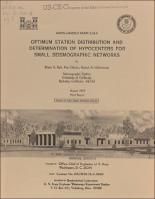Please use this identifier to cite or link to this item:
https://hdl.handle.net/11681/20713Full metadata record
| DC Field | Value | Language |
|---|---|---|
| dc.contributor | University of California, Berkeley. Seismographic Stations | - |
| dc.contributor | Soils and Pavements Laboratory (U.S.) | - |
| dc.contributor.author | Bolt, Bruce A., 1930-2005 | - |
| dc.contributor.author | Okubo, Paul | - |
| dc.contributor.author | Uhrhammer, Robert A. (Robert Allan) | - |
| dc.date.accessioned | 2017-01-17T21:33:59Z | - |
| dc.date.available | 2017-01-17T21:33:59Z | - |
| dc.date.issued | 1978-08 | - |
| dc.identifier.uri | http://hdl.handle.net/11681/20713 | - |
| dc.description | Miscellaneous Paper | - |
| dc.description | Abstract: Design of an optimal network of seismographs around a large reservoir to locate nearby earthquakes presents a number of theoretical and practical problems. This study discusses the aims of such networks and sets out general guidelines for network design to achieve these aims. The underlying variational problem is how to minimize and distribute the number of stations in order to achieve a desired level of precision in earthquake detection and hypocentral location. It is shown that a joint location method provides optimal solutions for clusters of earthquake hypocenters within a local network. A special FORTRAN program, called GHYP1 (available from the Seismographic Station, University of California has been written to do this joint reduction with simultaneous estimation of station adjustment terms. Sensitivity analyses for representative crustal models and network patterns provide guidelines for achievable hypocentral uncertainties. The problem of location of reservoir-associated seismicity is part of a more general inverse problem in which properties of the matrices of condition provide not only the variances and covariances of the estimates, but also indicate the sensitivity of the solution to changes in azimuths and distances of stations relative to the earthquake cluster. The mean seismic velocities in the rock layers under the reservoir can also be determined simultaneously with a trade-off between the resolution of the velocity estimates and their statistical uncertainties. Where possible, the type of seismograph and analysis system chosen should provide readings of both P and S phases for use in the matrix inversions. Two specific cases of earthquake sequences located near reservoirs in California are analyzed in detail using GHYP1: Oroville 1975 and Briones Hills 1977. A full explanation is given of the input and output expected for this joint location method. The program is suitable for routine use. | - |
| dc.publisher | Geotechnical Laboratory (U.S.) | - |
| dc.publisher | Engineer Research and Development Center (U.S.) | - |
| dc.relation | http://acwc.sdp.sirsi.net/client/en_US/search/asset/1045527 | - |
| dc.rights | Approved for public release; distribution is unlimited. | - |
| dc.source | This Digital Resource was created from scans of the Print Resource | - |
| dc.subject | Earthquakes | - |
| dc.subject | Seismic detection | - |
| dc.subject | GHYP1 | - |
| dc.subject | Computer program | - |
| dc.subject | Seismographs | - |
| dc.subject | Seismology | - |
| dc.subject | Hypocenters | - |
| dc.subject | Seismological stations | - |
| dc.subject | Reservoirs | - |
| dc.title | Optimum station distribution and determination of hypocenters for small seismographic networks | - |
| dc.type | Report | en_US |
| Appears in Collections: | Miscellaneous Paper | |
Files in This Item:
| File | Description | Size | Format | |
|---|---|---|---|---|
| MP-S-78-9.pdf | 4.65 MB | Adobe PDF |  View/Open |